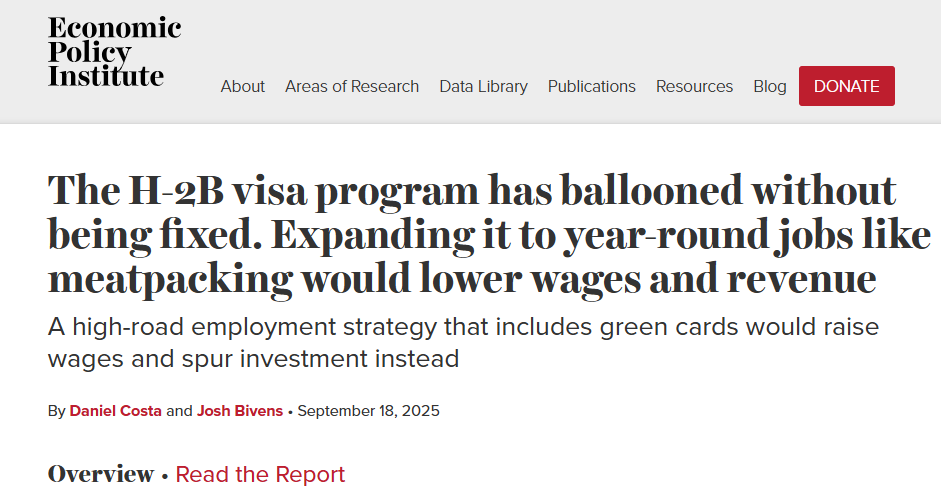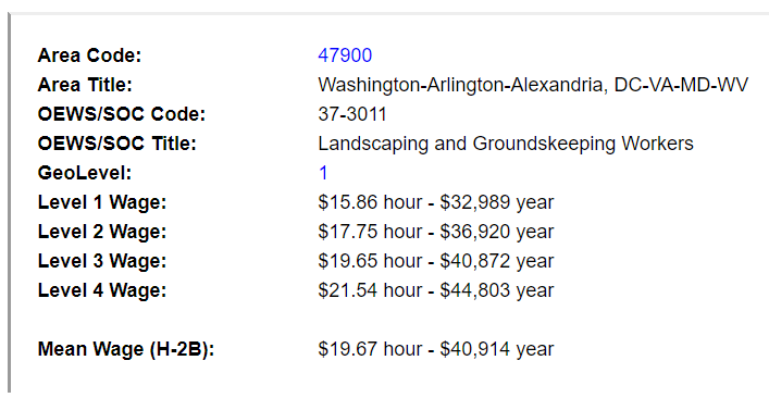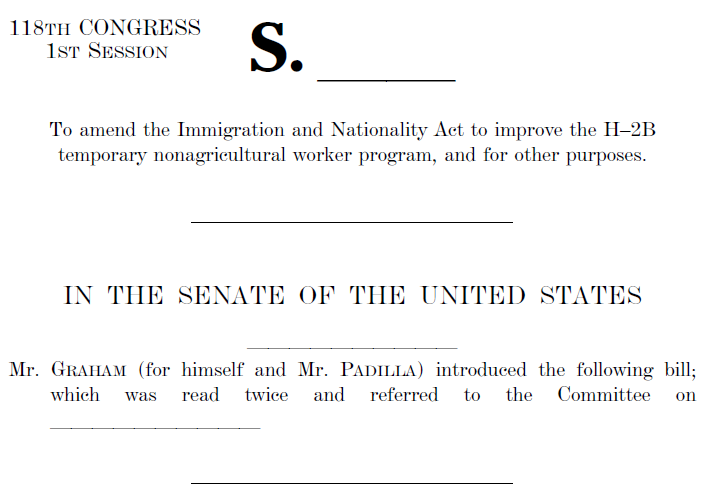SEA Responds to the Economic Policy Institute's H-2B Report

On September 18th Economic Policy Institute (EPI) issued a report titled, “The H-2B Visa Program Has Ballooned Without Being Fixed. Expanding It To Year-Round Jobs Like Meatpacking Would Lower Wages and Revenue.” Widely recognized as a think tank closely aligned with organized labor, EPI has consistently opposed the H-2B program—primarily because temporary foreign workers are difficult to unionize.
As part of its ongoing opposition, EPI recycles a report every few years with tired and demonstrably false assertions of widespread wage suppression and theft. This year, EPI introduced a new strawman argument by opposing a purported push by unnamed H-2Bstakeholders to expand the program to year-round industries like construction and meatpacking.
We will start with our points of agreement:
EPI: “H-2Bworkers are in a small number of industries and occupations for an average of7.6 months.”
By EPI’s own admission, the data shows that program use is limited to employers with temporary, short-term labor needs. Although regulations permit a season of up to 9 months(extended to 10 months under the Labor–HHS appropriations rider), the average requested period remains less than 8 months. This demonstrates not only a lack of a year-round need by employers, but also Department of Labor (DOL)’s effective policing of the regulatory standards for temporary need for purposes or program eligibility.
EPI: “One notable industry in which this push from employers for year-round H-2B workers is occurring is meatpacking—which we define as meat and poultry processing.”
We share EPI’s concern that employers with year-round needs, such as meatpackers, could attempt to use the H-2B program to address permanent labor shortages. The data, however, does not support EPI’s claim. In FY25, DOL certified a mere 856non-seafood meat processor positions, out of near 230,000 positions certified in the program. While companies such as Tyson Foods and Smithfield Foods sought H-2Bvisas in past years, neither company applied in FY25. This suggests that the program does not align with their long-term business models. It also likely reflects the difficulty in obtaining certification under DOL’s scrutiny of such needs.
Contrary to critics’ assertions, DOL’s approach to meatpacking, construction, and other traditionally year-round industries is far from a “rubber stamp.” For years, DOL has stringently enforced temporary need standards, and in FY25, only 36% of construction positions requested were approved.

To qualify for certification, employers bear the burden of proof in demonstrating a temporary need for workers under the regulatory standards. In its role, DOL conducts a holistic evaluation of the employer’s circumstances and evidence to ascertain not only that the labor need is temporary in nature, but also that the requested number of workers represents bona fide job opportunities open to American workers. Through its “labor market test,” DOL requires preferential hiring of American workers, and will deny an employer failing to demonstrate that no qualified U.S. workers are able, willing, and available to perform the job. Each application undergoes a rigorous review: if deficiencies are identified or the burden of proof is not met, DOL issues a Notice of Deficiency(NOD). An employer’s failure to remedy these deficiencies will result in adenial.
If EPI, Numbers USA or any other critic asserts flaws the DOL certification process is flawed, they should provide evidence to support such assertions – not just recycled talking points. If there are indeed gaps, the industry welcomes constructive solutions to improve DOL’s vetting process.
Regardless, we have previously supported limits on the meatpacking industry's access to the program. In the last Congress, we worked with labor unions and Senators Padilla and Graham to negotiate a historic reform measure, the Seasonal Employment Protection Act, which expressly prohibited meatpacking employers from using the program going forward.
EPI Continues to Report Misleading Information
EPI claims that “The available evidence makes clear that the H-2B wage rule is undercutting wage standards at the national level in H-2B occupations and is, therefore, not consistent with the law establishing the H-2B program. Employers should be required to offer at least the local, state, or national average wage for the occupation (whichever is highest), recruit U.S. workers nationwide, and offer to pay for housing and transportation for both U.S. and H-2B workers.”
U.S. Department of Labor (DOL) regulations already require that “the wages offered to a foreign worker must be the prevailing wage rate for the occupational classification in the area of employment.” The prevailing wage is defined as the average(mean) wage paid to similarly employed workers in that occupation and region. Since 2015, H-2B wages have been set at the mean wage, rather than the lower Level 1 rate. It is nonsensical and unrealistic to suggest that a commercial landscaper in rural Mississippi should pay the same wage as a comparable operation in the Chicago metro are. To do so ignores basic economic realities of regional labor markets.
To establish prevailing wages, DOL relies on the Bureau of Labor Statistics (BLS) data across every Metropolitan Statistical Area (MSA), including data that is specific to individual counties and cities over a 10-month cycle. The prevailing wages are, accordingly, targeted to specific localities. For employers operating across multiple MSAs, the highest rate applies. Contrary to EPI’s assertions, this “highest of” rule often results in H-2B wages that are artificially higher than what is prevailing in a particular location. It is the opposite of a race-to-the-bottom.
It is true that H-2Bwages may lag slightly behind market rates during periods of high inflation, but there is no practical system can capture real-time wages, nor is it tenable to require frequent mid-year wage adjustments. While not perfect, the existing methodology is transparent, consistently applied, and grounded in the best available federal data.
The Washington D.C. Metro area illustrates the process: the H-2B wage rate is drawn directly from the most recently BLS Occupational Employment Statistics (OES) dataset.


Figure 1: https://www.flcdatacenter.com/OesQuickResults.aspx?code=37-3011&area=47900&year=24&source=1
Figure 2: https://www.bls.gov/oes/current/oes_47900.htm#37-0000
EPI Does Not Consider Program Costs
EPI often looks another critical factor – the true cost of H-2B program participating beyond merely the cost of labor itself. To obtain H-2B workers, employers bear significant administrative expenses, including government filing fees, visa costs, worker travel and subsistence costs, and professional services fees. Due to the program’s complexity, nearly all employers rely on agents or attorneys to navigate the process (93% of FY24applications did so).
For example, this is the estimated cost for an employer to hire 10 H-2B workers:
- USCIS Petition Fee: $2,595 (small employer) or $3,015 (large employer)
- Visa Fees: $205 per worker for a machine-readable visa, plus $6 border crossing fee ($2,110 total for 10 workers)
- Travel Costs: ~$800 per worker round trip ($8,000 total for 10 workers)
- Legal/Agent Fees: ~$4,000 for filing assistance
- Worker Agent Costs Abroad: ~$100 per worker ($1,000 total for 10 workers)
Total Estimated Cost for 10 Workers: ~$26,125
Given that the FY25 average H-2B work season was 31.8 weeks (1,272 hours total), this translates to an additional $2.05 per hour in program costs for the employer. In the Washington D.C. Metro area, the effective hourly cost rises to $21.12, approaching the Level 4 wage, which represents the top 25% of wage distribution for this occupation.

This demonstrates that employers do not turn to H-2B for “cheap labor.” Instead, they participate despite high costs because they cannot find sufficient domestic workers. The H-2B program is a last resort, not a first choice.
EPI: asserts that “Wage theft is a massive problem in major H-2B industries: Employers have stolen over $2.2 billion from workers since 2000.”
Repetition does not equal accuracy. EPI’s claim is recycled from its August 2022 report[1]and remains misleading. The Department of Labor (DOL) does not publish data showing back wages specifically tied to H-2B program participants. Instead, EPI extrapolates from broad industry-level data that covers all workers, U.S. citizens, permanent residents, H-2B workers, and even unauthorized workers, without isolating H-2B-specific violations.
The below quote is taken directly from their 2022 report.
“It is important to note that the violations and back wages owed that are detailed in these tables from WHD do not represent enforcement actions that involve only H-2B workers; they represent violations and back wages owed to any workers in the seven selected H-2B industries. These may include U.S. citizens, lawful permanent residents (i.e., green cardholders), H-2B workers, or workers of any other immigration status, including unauthorized immigrant workers.” [2]
A far different picture emerges when one reviews the actual DOL data. Between 2012 and 2021, back wages assessed specifically to H-2B employers in the top seven H-2Bindustries totaled approximately 1% of the total back wages assessed. Out of $1.8 billion in total back wages over that period, only about $17.3million was directly attributable to H-2B employers.
From 2012-2021, H-2B back wages accounted for only 1% of the total amount of back wages assessed. The DOL data does not provide H-2B back wages from 2000-2010 (and the data was incomplete for 2011). We therefore calculated the percentage of back wages directly attributed to H-2B violations using the same data EPI claims to have utilized in their report. Of the total $1.8 billion in back wages assessed by DOL over the past 20 years, the amount attributable to H-2Bemployers in the same seven H-2B occupations surveyed by EPI is approximately$17,360,241 – or less than 1%.
While $17 million is not insignificant, it represents a de minimis fraction of the billions of dollars in total wages paid to H-2B workers over the past two decades. In context, H-2B wage violations are rare, representing approximately 1% of wages paid. This is far from the “massive problem” that EPI alleges.
[1]https://www.epi.org/publication/h-2b-industries-and-wage-theft/
[2][2] https://www.epi.org/publication/h-2b-industries-and-wage-theft/

.png)
.jpg)
